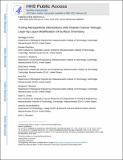| dc.contributor.author | Correa, Santiago | |
| dc.contributor.author | Boehnke, Natalie | |
| dc.contributor.author | Barberio, Antonio E | |
| dc.contributor.author | Deiss-Yehiely, Elad | |
| dc.contributor.author | Shi, Aria | |
| dc.contributor.author | Oberlton, Benjamin | |
| dc.contributor.author | Smith, Sean G | |
| dc.contributor.author | Zervantonakis, Ioannis | |
| dc.contributor.author | Dreaden, Erik C | |
| dc.contributor.author | Hammond, Paula T | |
| dc.date.accessioned | 2022-01-26T15:09:01Z | |
| dc.date.available | 2021-10-25T16:31:24Z | |
| dc.date.available | 2022-01-26T15:09:01Z | |
| dc.date.issued | 2020-01 | |
| dc.date.submitted | 2019-11 | |
| dc.identifier.issn | 1936-0851 | |
| dc.identifier.issn | 1936-086X | |
| dc.identifier.uri | https://hdl.handle.net/1721.1/133090.2 | |
| dc.description.abstract | © 2020 American Chemical Society. Nanoparticle surface chemistry is a fundamental engineering parameter that governs tumor-targeting activity. Electrostatic assembly generates controlled polyelectrolyte complexes through the process of adsorption and charge overcompensation utilizing synthetic polyions and natural biomacromolecules; it can yield films with distinctive hydration, charge, and presentation of functional groups. Here, we used electrostatic layer-by-layer (LbL) assembly to screen 10 different surface chemistries for their ability to preferentially target human ovarian cancer in vitro. Our screen identified that poly-l-aspartate, poly-l-glutamate, and hyaluronate-coated LbL nanoparticles have striking specificity for ovarian cancer, while sulfated poly(β-cyclodextrin) nanoparticles target noncancerous stromal cells. We validated top candidates for tumor-homing ability with a murine model of metastatic disease and with patient-derived ovarian cancer spheroids. Nanoparticle surface chemistry also influenced subcellular trafficking, indicating strategies to target the cell membrane, caveolae, and perinuclear vesicles. Our results confirm LbL is a powerful tool to systematically engineer nanoparticles and achieve specific targeting. | en_US |
| dc.language.iso | en | |
| dc.publisher | American Chemical Society (ACS) | en_US |
| dc.relation.isversionof | http://dx.doi.org/10.1021/ACSNANO.9B09213 | en_US |
| dc.rights | Creative Commons Attribution-Noncommercial-Share Alike | en_US |
| dc.rights.uri | http://creativecommons.org/licenses/by-nc-sa/4.0/ | en_US |
| dc.source | PNAS | en_US |
| dc.title | Tuning Nanoparticle Interactions with Ovarian Cancer through Layer-by-Layer Modification of Surface Chemistry | en_US |
| dc.type | Article | en_US |
| dc.identifier.citation | Correa, Santiago, Boehnke, Natalie, Barberio, Antonio E, Deiss-Yehiely, Elad, Shi, Aria et al. 2020. "Tuning Nanoparticle Interactions with Ovarian Cancer through Layer-by-Layer Modification of Surface Chemistry." ACS Nano, 14 (2). | en_US |
| dc.contributor.department | Massachusetts Institute of Technology. Department of Biological Engineering | |
| dc.contributor.department | Koch Institute for Integrative Cancer Research at MIT | |
| dc.contributor.department | Massachusetts Institute of Technology. Department of Chemical Engineering | |
| dc.contributor.department | Massachusetts Institute of Technology. Department of Materials Science and Engineering | |
| dc.contributor.department | Massachusetts Institute of Technology. Institute for Soldier Nanotechnologies | |
| dc.relation.journal | ACS Nano | en_US |
| dc.eprint.version | Author's final manuscript | en_US |
| dc.type.uri | http://purl.org/eprint/type/JournalArticle | en_US |
| eprint.status | http://purl.org/eprint/status/PeerReviewed | en_US |
| dc.date.updated | 2021-06-10T15:40:52Z | |
| dspace.orderedauthors | Correa, S; Boehnke, N; Barberio, AE; Deiss-Yehiely, E; Shi, A; Oberlton, B; Smith, SG; Zervantonakis, I; Dreaden, EC; Hammond, PT | en_US |
| dspace.date.submission | 2021-06-10T15:40:54Z | |
| mit.journal.volume | 14 | en_US |
| mit.journal.issue | 2 | en_US |
| mit.license | OPEN_ACCESS_POLICY | |
| mit.metadata.status | Authority Work Needed | en_US |
